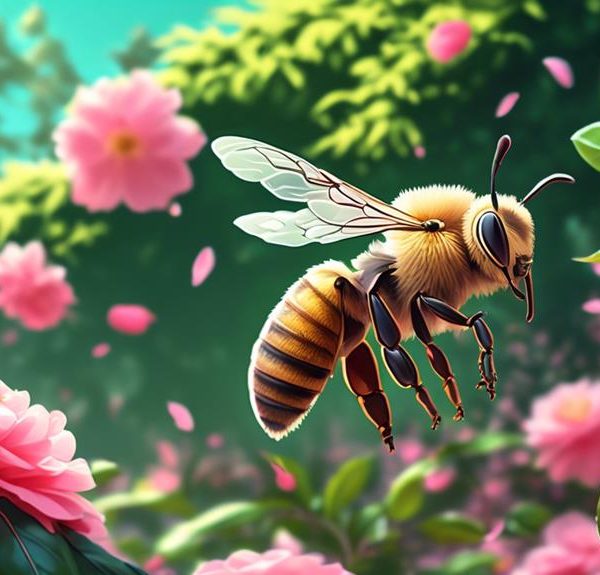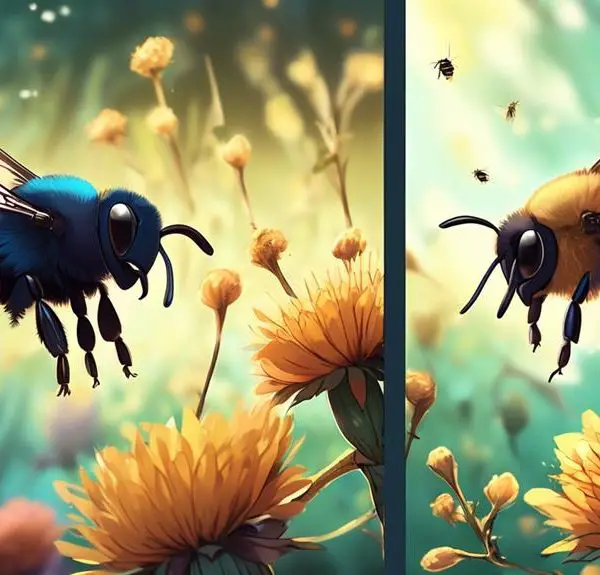Observe how black and yellow mason bees' distinct colors and unique behaviors impact your garden's ecosystem.
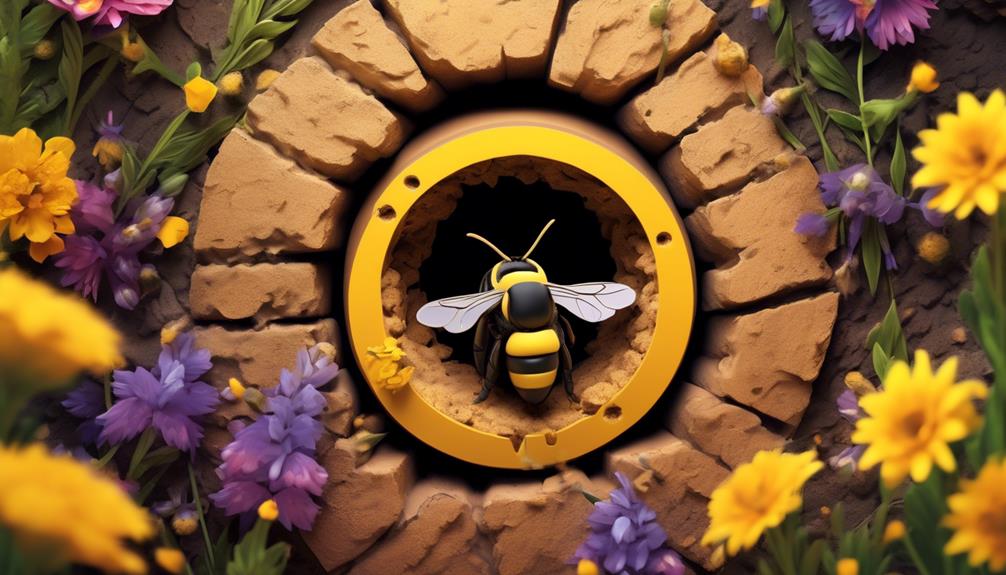
Are Any Mason Bees Black and Yellow
Imagine you're a gardener, observing the busy hum of life in your lush paradise. You notice a small, industrious creature buzzing about, its black and yellow hues a stark contrast against the vibrant greenery.
It's a bee, but is it the common honeybee or could it be a mason bee? You might be surprised to learn that mason bees, known for their solitary behavior and impressive pollinating abilities, can indeed sport these familiar colors.
But what does this mean for your garden, and how does it affect the behavior of these fascinating insects? We'll explore these intriguing questions and more as we delve into the vibrant world of mason bees.
Key Takeaways
- Mason bees come in a wide range of color variations, including metallic blue, green, and rust-brown, with some species having combinations of colors.
- Black and yellow mason bees have unique survival strategies, using their coloration for camouflage and as a warning signal to potential predators.
- The color scheme of black and yellow mason bees plays a significant role in attracting mates and is intricately linked to their survival and propagation.
- Mason bees, including the black and yellow species, are less aggressive and more efficient pollinators compared to honeybees, and their coloration may help them blend into preferred floral environments.
Understanding Mason Bees
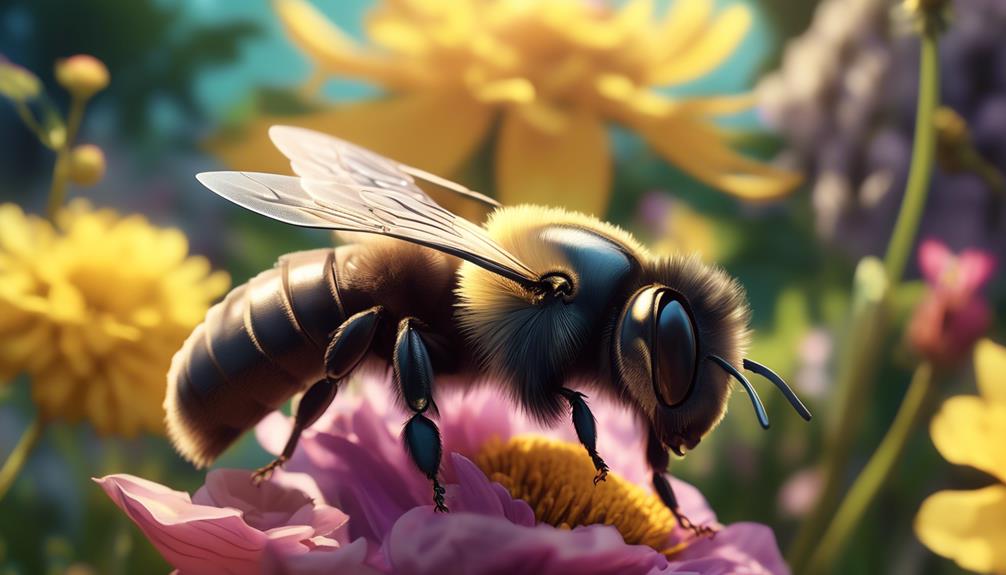
To truly comprehend the nature of Mason Bees, it's crucial to delve into their unique characteristics, behaviors, and role in the ecosystem. Unlike typical honeybees that reside in large colonies, Mason bees are solitary creatures. They're named for their habit of using mud or clay ('masonry') to construct their nests, often in pre-existing hollows or crevices. You'll often find them in holes in wood or even in the ground.
Mason Bees aren't aggressive and only sting if directly threatened, making them a desirable neighbor in your garden. They're also highly efficient pollinators. A single Mason Bee can pollinate as much as a hundred honeybees, contributing significantly to the biodiversity of your garden and the broader ecosystem.
Their life cycle is fascinating. After the female lays her eggs, she seals them in the nest with mud. Come spring, the larvae emerge as fully formed adults. Each female then starts the cycle again, ensuring the continuation of the species.
Understanding these aspects of Mason Bees' behavior helps us appreciate their crucial role in nature and our own lives.
Mason Bees: Color Variations
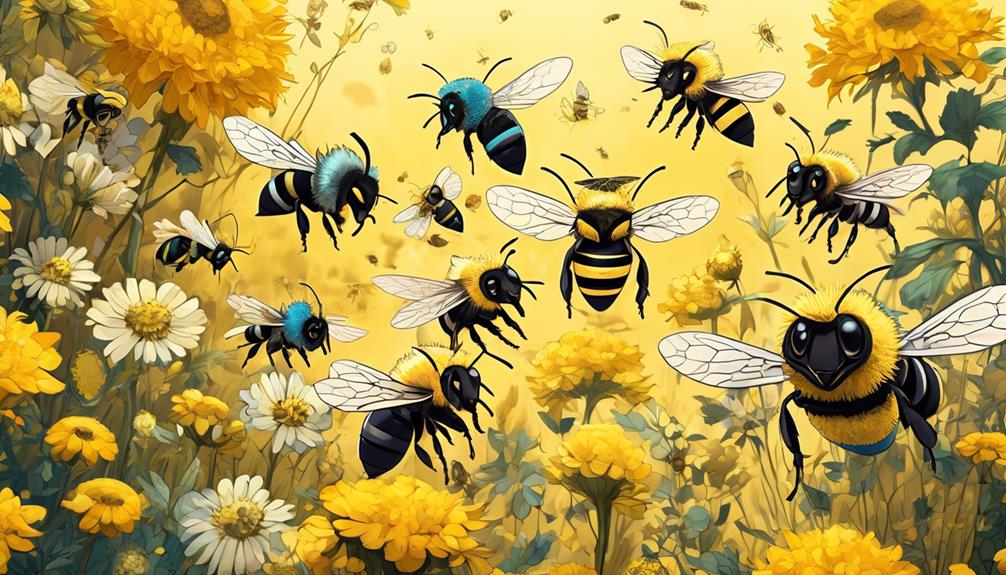
Despite their common black and yellow depiction, Mason Bees actually exhibit a wide range of color variations, each unique to their specific species and geographical location. You'd be surprised to learn the spectrum of colors these fascinating creatures display.
They can be metallic blue, green, or even a rust-brown. Some species present a combination of colors, making them an intriguing subject for study. Their color diversity is not just for aesthetic purposes; it plays a critical role in their survival strategy.
Species | Location | Color |
|---|---|---|
Osmia lignaria | North America | Blue, Green |
Osmia bicornis | Europe | Black, Red |
Osmia cornifrons | Asia | Dark Blue |
Osmia ribifloris | North America | Metallic Green |
Osmia rufa | Europe | Rusty Red |
This table represents a small sample of the color variations found in different Mason Bee species worldwide. As you delve deeper into the world of Mason Bees, you'll discover the complexity of their color variations and how they're intertwined with their life cycles and mating rituals. It's a biological masterpiece that showcases the beauty of nature's diversity.
The Black and Yellow Mason Bees

In the vast realm of Mason Bee colors, the black and yellow species hold a unique and captivating allure, offering an intriguing insight into their survival strategies and mating rituals. You might wonder why these bees sport such vibrant hues. The answer lies in their need for camouflage and communication.
From a scientific perspective, the black and yellow coloration isn't just aesthetic; it's a survival tactic. The stark contrast allows them to blend into their environment, dodging potential predators. Moreover, the bright yellow signals a warning to any creature that might pose a threat, a phenomenon known as aposematism.
On the other hand, this color scheme plays a significant role in attracting mates. The males use their striking coloration to entice females during courtship, indicating strong genes and a promising genetic lineage.
When you delve into the world of these black and yellow mason bees, you'll find that their coloration is intricately linked to their survival and propagation. Each aspect of their color pattern serves a purpose, demonstrating nature's efficiency and the fascinating intricacy of bee biology.
Comparing Mason Bees to Other Species

When you compare mason bees to other species, you'll notice stark differences in their behavior, habitat preferences, and physical characteristics, further highlighting their unique black and yellow coloration's role in survival.
Unlike honeybees, mason bees are solitary creatures. They don't live in hives, but prefer to nest in small cavities in wood or hollow stems.
In physical terms, mason bees are smaller and less fuzzy than bumblebees. Their wings are usually darker, and their bodies leaner. The black and yellow coloration serves as a warning signal to potential predators, a common survival strategy in the animal kingdom known as aposematic coloration.
Now, let's consider their behavior. Mason bees are less aggressive than many bee species. They're also more efficient pollinators. Whereas honeybees may visit several types of flowers in one outing, mason bees stick to one type, reducing cross-pollination.
Their habitat preference also differs. Rather than building elaborate hives, mason bees make their nests in pre-existing holes, sealing each cell with mud. This preference for solitary living and efficient pollination makes mason bees crucial for maintaining biodiversity.
Impact of Color on Bee Behavior
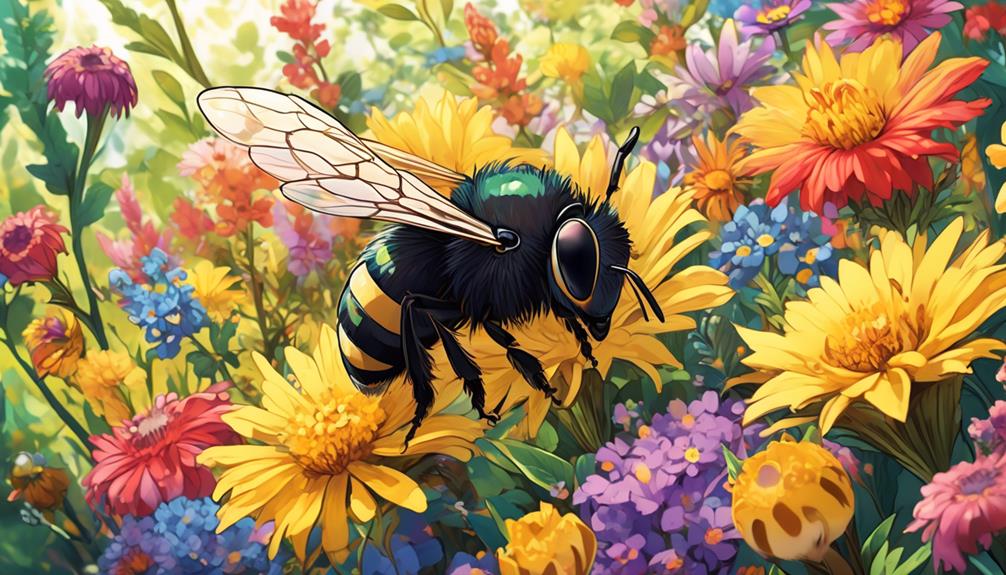
Building on the unique characteristics of mason bees, let's explore how their distinct black and yellow coloration impacts their behavior. Research indicates that color plays a crucial role in the daily activities of many bee species, including mason bees. It's not just about aesthetics; it's about survival.
The black and yellow of mason bees serve as visual signals for both predator avoidance and mate attraction. Predators often associate bright colors with danger or toxicity, a phenomenon known as aposematism. Therefore, the yellow patterning on a black body can act as a deterrent, providing the mason bees with a protective advantage. On the flip side, the vibrant hues also attract potential mates, playing a vital role in the reproductive success of the species.
Moreover, color influences their foraging habits. Bees are trichromatic and perceive color differently than humans. They're attracted to certain colors, like yellow and blue, which guide them to nectar-rich flowers. The black and yellow coloration of mason bees may help them blend into these preferred floral environments, increasing their efficiency in gathering food.
Frequently Asked Questions
What Is the Lifespan of a Typical Mason Bee?
You're probably wondering about the lifespan of a typical mason bee. Well, it's not long compared to human standards.
Typically, they live around 6 to 8 weeks. The females, who emerge in the spring, live about 6 weeks, while the males have an even shorter lifespan. They don't make it past springtime.
However, the larvae stay in their cocoon throughout winter, ready to emerge when the warm weather returns.
How Does the Environment or Climate Affect the Color of Mason Bees?
Yes, the environment or climate can impact the color of mason bees. Warmer climates often produce bees with darker colors, as they absorb heat more efficiently. Conversely, cooler climates tend to have lighter-colored bees.
However, it's not just temperature. Factors like humidity, altitude, and the bees' diet can also influence their coloration.
What Are Some Predators of the Black and Yellow Mason Bees?
You're curious about the predators of black and yellow mason bees. Birds, spiders, and certain insect species pose threats to these bees.
Predatory wasps are problematic, often laying their eggs in mason bee nests. Once hatched, wasp larvae consume the bee eggs or larvae.
Additionally, bears and humans can disrupt their habitats.
It's important to note that threats can vary based on location, highlighting the complex relationship between these bees and their environment.
How Can I Attract Mason Bees to My Garden?
You can attract mason bees to your garden by providing them with a suitable habitat.
Plant a variety of native flowering plants, as they're a key food source for these bees.
You'll also want to provide nesting sites. Mason bees prefer small, hollow tubes, so consider installing a bee house.
Avoid using pesticides in your garden, as they can be harmful to these beneficial insects.
With the right conditions, you'll have mason bees buzzing around in no time.
What Role Do Mason Bees Play in the Ecosystem or Agriculture?
You're likely aware that mason bees are crucial for pollination. They're more efficient pollinators than honeybees, which means they're vital to our ecosystem and agriculture.
They pollinate a variety of plants, contributing to plant diversity and food production. They're also less aggressive than other bees.
Conclusion
So, you've discovered that Mason bees, while often metallic blue or green, can indeed sport black and yellow hues. They're not just about looks, though. These color variations impact their behavior and interaction with their environment, distinguishing them from other species.
Understanding these nuances broadens our knowledge of these industrious insects, highlighting their vital role in our ecosystem.
So, next time you spot a black and yellow bee, remember it may be a hardworking Mason bee!

